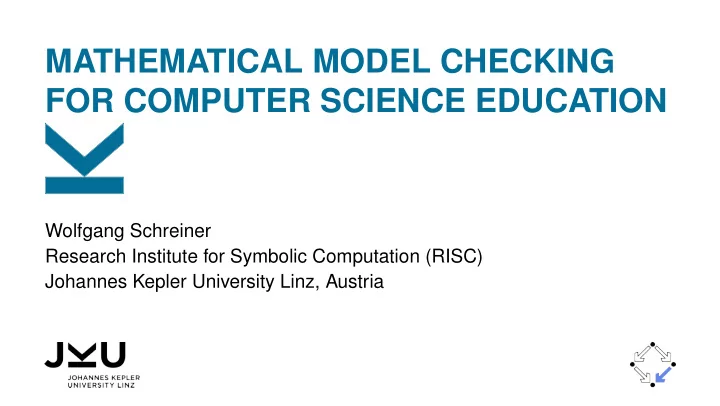

MATHEMATICAL MODEL CHECKING FOR COMPUTER SCIENCE EDUCATION Wolfgang Schreiner Research Institute for Symbolic Computation (RISC) Johannes Kepler University Linz, Austria
Formal Modeling&Reasoning in Education Typically still presented as “paper and pencil” topics. 1/23
Formal Modeling&Reasoning in Education But today the educational process can be substantially supported by software . 2/23
Projects LOGTECHEDU and SemTech � LOGTECHEDU: Logic Technologies for Computer Science Education. � JKU LIT (Linz Institute of Technology), 2018–2020. � Institutes FMV (Biere, Cerna, Seidl) and RISC (Schreiner, Windsteiger). � ❤tt♣✿✴✴❢♠✈✳❥❦✉✳❛t✴❧♦❣t❡❝❤❡❞✉ � SemTech: Semantic Technologies for Computer Science Education. � Austrian OEAD WTZ and Slovak SRDA, 2018–2019. � JKU Linz (Schreiner) and TU Kosice (Novitzká, Steingartner). � ❤tt♣s✿✴✴✇✇✇✳r✐s❝✳❥❦✉✳❛t✴♣r♦❥❡❝ts✴❙❡♠❚❡❝❤ Investigate the potential of formal modeling&reasoning software for education. 3/23
Educating with the Help of Formal Models � Today much of modeling&reasoning can be automated by computer software. � Substantial advances in computational logic (automated reasoning, model checking, satisfiability solving). � By the application of such software education may be supported. � May demonstrate the practical usefulness of theory. � May increase the motivation of students to model and to reason. � The ultimate goal is self-directed learning. � Teachers become “enablers” by providing basic knowledge and skills. � Students “educate themselves” by solving problems. • (Voluntary) quizzes, (mandatory) assignments, possibly (graded) exams. Core idea: let students actively engage with lecturing material by solving concrete problems and by receiving immediate feedback from the software. 4/23
Research Strands � Solver Guided Exercises (Limboole, Boolector) � Teaching Solver Technology (Limboole, Boolector) � Proof Assistants for Education (Theorema, AXolotl) � Specification and Verification Systems for Education (RISCAL) � Formal Semantics of Programming Languages ( J ane ) � Logic across the Subjects in Primary, Secondary and Higher Education Various aspects of the general idea. 5/23
Example: AXolotl Author: David Cerna; Google Play Store (search for “AXolotl Logic Software”) � � � Proving on a smartphone by a purely touch-based interface (no keyboard input). 6/23
The RISC Algorithm Language (RISCAL) A language and software system for investigating finite mathematical models (i.e., a “mathematical model checker”). � Formulation of mathematical theories and theorems. � Formulation and specification of (also non-deterministic) algorithms. � Rooted in strongly typed first order logic and set theory. � All types are finite (with sizes determined by model parameters). � All formulas are automatically decidable. � Correctness of all algorithms is decidable. � Automatic generation of (again decidable) verification conditions. Checking in some model of fixed size before proving in models of arbitrary size. 7/23
The RISCAL Software ❤tt♣s✿✴✴✇✇✇✳r✐s❝✳❥❦✉✳❛t✴r❡s❡❛r❝❤✴❢♦r♠❛❧✴s♦❢t✇❛r❡✴❘■❙❈❆▲ 8/23
Theories and Theorems First-order logic, integers, tuples/records, arrays/maps, sets, algebraic types. 9/23
Declarative Algorithms Functions, predicates, implicitly defined constants and functions. 10/23
Imperative Algorithms Procedures, variables, loops. 11/23
Transition Systems Nondeterministic systems defined by initial state condition and next state relation. 12/23
RISCAL Checking ❯s✐♥❣ ◆❂✷✳ ❚②♣❡ ❝❤❡❝❦✐♥❣ ❛♥❞ tr❛♥s❧❛t✐♦♥ ❝♦♠♣❧❡t❡❞✳ ✳✳✳ ❊①❡❝✉t✐♥❣ ♥♦t❱❛❧✐❞✭❙❡t❬❙❡t❬ Z ❪❪✮ ✇✐t❤ s❡❧❡❝t❡❞ ✺✶✷ ✐♥♣✉ts✳ ❊①❡❝✉t✐♦♥ ❝♦♠♣❧❡t❡❞ ❢♦r ❙❊▲❊❈❚❊❉ ✐♥♣✉ts ✭✶✶✶ ♠s✱ ✺✶✷ ❝❤❡❝❦❡❞✱ ✵ ✐♥❛❞♠✐ss✐❜❧❡✮✳ ❊①❡❝✉t✐♥❣ ❉P▲▲✭❙❡t❬❙❡t❬ Z ❪❪✮ ✇✐t❤ s❡❧❡❝t❡❞ ✺✶✷ ✐♥♣✉ts✳ ❊①❡❝✉t✐♦♥ ❝♦♠♣❧❡t❡❞ ❢♦r ❙❊▲❊❈❚❊❉ ✐♥♣✉ts ✭✶✷✶✾ ♠s✱ ✺✶✷ ❝❤❡❝❦❡❞✱ ✵ ✐♥❛❞♠✐ss✐❜❧❡✮✳ ❊①❡❝✉t✐♥❣ ❉P▲▲✷✭❙❡t❬❙❡t❬ Z ❪❪✮ ✇✐t❤ s❡❧❡❝t❡❞ ✺✶✷ ✐♥♣✉ts✳ ✹✸✺ ✐♥♣✉ts ✭✹✸✺ ❝❤❡❝❦❡❞✱ ✵ ✐♥❛❞♠✐ss✐❜❧❡✱ ✵ ✐❣♥♦r❡❞✮✳✳✳ ❊①❡❝✉t✐♦♥ ❝♦♠♣❧❡t❡❞ ❢♦r ❙❊▲❊❈❚❊❉ ✐♥♣✉ts ✭✷✹✸✻ ♠s✱ ✺✶✷ ❝❤❡❝❦❡❞✱ ✵ ✐♥❛❞♠✐ss✐❜❧❡✮✳ ❊①❡❝✉t✐♥❣ ❉P▲▲❴❖✉t♣✉t❈♦rr❡❝t✭❙❡t❬❙❡t❬ Z ❪❪✮ ✇✐t❤ s❡❧❡❝t❡❞ ✺✶✷ ✐♥♣✉ts✳ ❊①❡❝✉t✐♦♥ ❝♦♠♣❧❡t❡❞ ❢♦r ❙❊▲❊❈❚❊❉ ✐♥♣✉ts ✭✻✵✾ ♠s✱ ✺✶✷ ❝❤❡❝❦❡❞✱ ✵ ✐♥❛❞♠✐ss✐❜❧❡✮✳ Automatic checking of theorems, algorithms, generated verification conditions. 13/23
Application: Mathematical Modeling ❊①❡❝✉t✐♥❣ ❊①✐sts✶✭ Z ✱❙❡t❬❆rr❛②❬ Z ❪❪✮ ✇✐t❤ ❛❧❧ ✼✻✽ ✐♥♣✉ts✳ ❊①❡❝✉t✐♦♥ ❝♦♠♣❧❡t❡❞ ❢♦r ❆▲▲ ✐♥♣✉ts ✭✹✸✶✶ ♠s✱ ✼✻✽ ❝❤❡❝❦❡❞✱ ✵ ✐♥❛❞♠✐ss✐❜❧❡✮✳ ❊①❡❝✉t✐♥❣ ❊①✐sts✷✭ Z ✱❙❡t❬❆rr❛②❬ Z ❪❪✮ ✇✐t❤ ❛❧❧ ✼✻✽ ✐♥♣✉ts✳ ❊①❡❝✉t✐♦♥ ❝♦♠♣❧❡t❡❞ ❢♦r ❆▲▲ ✐♥♣✉ts ✭✶✻✼✹ ♠s✱ ✼✻✽ ❝❤❡❝❦❡❞✱ ✵ ✐♥❛❞♠✐ss✐❜❧❡✮✳ Validating conjectures (respectively the formalization of theorems). 14/23
Application: Specifying and Verifying Algorithms � ❊①❡❝✉t✐♥❣ ❣❝❞♣✭ Z ✱ Z ✮ ✇✐t❤ ❛❧❧ ✶✷✶ ✐♥♣✉ts✳ ❊①❡❝✉t✐♦♥ ❝♦♠♣❧❡t❡❞ ❢♦r ❆▲▲ ✐♥♣✉ts ✭✶✼✷ ♠s✱ ✶✷✵ ❝❤❡❝❦❡❞✱ ✶ ✐♥❛❞♠✐ss✐❜❧❡✮✳ ✳✳✳ ❊①❡❝✉t✐♥❣ ❴❣❝❞♣❴✺❴Pr❡❖♣✸✭ Z ✱ Z ✮ ✇✐t❤ ❛❧❧ ✶✷✶ ✐♥♣✉ts✳ ✽✼ ✐♥♣✉ts ✭✽✻ ❝❤❡❝❦❡❞✱ ✶ ✐♥❛❞♠✐ss✐❜❧❡✱ ✵ ✐❣♥♦r❡❞✮✳✳✳ ❊①❡❝✉t✐♦♥ ❝♦♠♣❧❡t❡❞ ❢♦r ❆▲▲ ✐♥♣✉ts ✭✷✽✹✸ ♠s✱ ✶✷✵ ❝❤❡❝❦❡❞✱ ✶ ✐♥❛❞♠✐ss✐❜❧❡✮✳ Validating algorithms, their specification, annotations, verification conditions. 15/23
RISCAL Approach to Model Checking/Formula Decision ComSem := Single + Multiple Single := Command → ( Context → Context ) Multiple := Command → ( Context → Seq ( Context )) Seq ( T ) := Unit → ( Null + Next ( T, Seq ( T ))) [ . ] : ❈♦♠♠❛♥❞ → Single [ ✐❢ E t❤❡♥ C ] := λc. ✐❢ [ E ] ( c ) t❤❡♥ [ C ] ( c ) ❡❧s❡ c ✐♥t❡r❢❛❝❡ ❈♦♠❙❡♠ ④ ♣✉❜❧✐❝ ✐♥t❡r❢❛❝❡ ❙✐♥❣❧❡ ❡①t❡♥❞s ❈♦♠❙❡♠✱ ❋✉♥❝t✐♦♥❁❈♦♥t❡①t✱❈♦♥t❡①t❃ ④ ⑥ ♣✉❜❧✐❝ ✐♥t❡r❢❛❝❡ ▼✉❧t✐♣❧❡ ❡①t❡♥❞s ❈♦♠❙❡♠✱ ❋✉♥❝t✐♦♥❁❈♦♥t❡①t✱❙❡q❁❈♦♥t❡①t❃ ❃ ④ ⑥ ⑥ ✐♥t❡r❢❛❝❡ ❙❡q❁❚❃ ❡①t❡♥❞s ❙✉♣♣❧✐❡r❁❙❡q✳◆❡①t❁❚❃ ❃ ④ ✳✳✳ ⑥ ❈♦♠❙❡♠✳❙✐♥❣❧❡ ✐❢❚❤❡♥❊❧s❡✭❇♦♦❧❊①♣❙❡♠✳❙✐♥❣❧❡ ❊✱ ❈♦♠❙❡♠✳❙✐♥❣❧❡ ❈✮ ④ r❡t✉r♥ ✭❈♦♥t❡①t ❝✮ ✲❃ ❊✳❛♣♣❧②✭❝✮ ❄ ❈✳❛♣♣❧②✭❝✮ ✿ ❝❀ ⑥ Translation of every RISCAL phrase to its (potentially nondeterministic) semantics 16/23 and the execution of this semantics.
RISCAL Formula Decision (Experimental Alternative) ✭s❡t✲❧♦❣✐❝ ◗❋❴❯❋❇❱✮ ✭❞❡❝❧❛r❡✲❢✉♥ ①✭✮ ✭❴ ❇✐t❱❡❝ ✹✮✮ ✭❞❡❢✐♥❡✲❢✉♥ ②✭✮ ✭❴ ❇✐t❱❡❝ ✹✮★❜✵✵✵✶✮ ✭❛ss❡rt ✭♥♦t ✭❜✈✉❧❡ ① ✭❜✈❛❞❞ ① ②✮✮✮✮ ✭❝❤❡❝❦✲s❛t✮ ✭❡①✐t✮ � Translation of RISCAL theory to SMT-LIB. � Author: Franz-Xaver Reichl (master thesis). � QF_UFBV: quantifier-free formulas over bitvectors with uninterpreted functions. � Well supported by various SMT solvers: Boolector, Z3, Yices, CVC4, . . . � Elimination of quantifiers by skolemization and expansion. � Translation of integers, tuples/records, arrays/maps, sets, . . . to bit vectors. • Non-trivial because, e.g., RISCAL uses “true” mathematical integers. Much faster in many (not all) cases, systematic benchmarks under way. 17/23
RISCAL Visualization Pruned evaluation trees to explain the truth value of a formula. 18/23
Recommend
More recommend